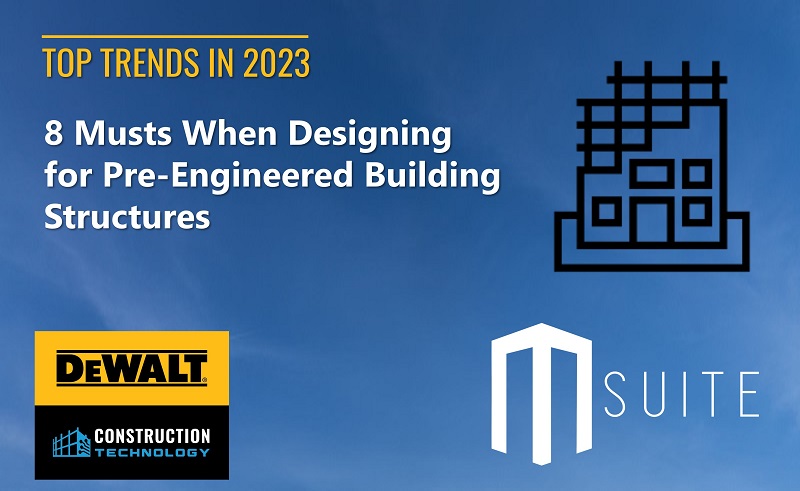Pre-Engineered building structures are gaining substantial traction because of their many benefits, and contractors are now choosing prefabricated and modular construction over traditional methods. Prefabrication is nothing but a method of construction that includes the following:
- Manufacturing of components in a factory setting
- Transporting components to the desired site
- Assembling components on the site
But how does designing a pre-engineered building (PEB) structure or component beforehand help you build? With a combination of good design and modern performance similar to traditional building, here are a few essential things to consider while designing pre-engineered structures.
1. Project Type, Size, and Purpose
Clarifying the purpose of building this new structure is the first step. Acknowledge these questions:
- What is the goal of making the structure and components?
- How will the project meet your purpose?
- How large do you want your design to be?
- How can the component be compatible with the type of project?
- How can parts be easily exchanged?
Be clear about the type, size, and purpose of designing the component by getting answers to these questions for the accurate architectural design of the structure. Once you know your goals, you can more easily create the pre-engineered element according to your customer’s needs or personal requirements.
2. Rules and Digital Documentation
When you are busy designing, planning, and building your elements, reviewing the laws, licenses, and permits needed to construct your components is essential. Specific codes, rules, and regulations exist for developing a pre-engineered part. Then, as manufacturing components for a fabricated structure are created in the factory-like setting, the pieces are quality controlled and meet the demands of the National Building Codes. Be aware of the required documentation, codes, and laws applicable in your project’s region. Below are just a few resources to utilize.
- Breaking Down the “Modular Building Code”
- Building Codes – NAHB
- The International Building Code
- Understanding Building Codes | NIST
- Building Codes by U.S. State
Once well-versed with them, you can obtain the necessary licenses and permits and design your structure according to local and state laws. Finally, implement the most valuable opportunities in your design to make the construction process faster.
3. Site Access
There is a need for cranes and lifts to position the components of your pre-engineered structure on your jobsite if your project is vast. Therefore, you must ensure that the construction site is suitable and bears the weight of the cranes and lifts required for the job. If the jobsite can easily have open access, you can avoid additional costs and delays by developing a base for heavy machinery.
4. Transportation Requirements
If your project is massive, you must consider the transportation costs of several prefabricated materials to the jobsite for final assembly. Make sure you include these costs in the overall budget of your construction project so that you stay within your budget and avoid difficulties later. Additionally, transportation regulations must be considered while transporting the components to the predetermined location. Understanding these regulations and requirements can ensure you meet your deadline.
5. Materials and Workmanship
Pre-engineered structures are usually constructed with lightweight materials making them easier to transport and lift. Selecting materials that are:
- Safe
- Transportable
- Lightweight
- Durable
- Easily workable
- Non-combustible
Though prefabricated structures require less labor than traditional construction, you must consider the experience and capabilities of the installers necessary on the jobsite. Ensure that you have a team of skilled workers to handle and work with your chosen materials. In addition, prefabrication offers better quality because of the quality control measures to check components before being shipped and after installing prefabricated components.
6. Insulation and Ventilation
Ventilation replaces the stale air in the building with fresh air to eliminate stale air and foul smell. Also, there will be a rise in the concentration of carbon dioxide, humidity, and temperature. You may choose natural ventilation by installing windows, doors, roofs, and wall ventilators. Even mechanical ventilators can be an excellent option to extract the stale air in the building, leading to a more productive shop floor.
7. Time and Convenience
While you are building a pre-engineered structure, the jobsite may not be available for any activity for an extended period. In some cases, you will need to find a temporary facility relatively close to the jobsite for convenience. Keep in mind this can add a substantial cost to your budget, so remember to account for this in your original budget.
Prefabrication also helps address unpredictable factors impacting the construction process, such as poor weather. In addition, since prefab construction takes less build time, your schedule becomes more predictable and can be accelerated to finish early and often with more consistent quality.
8. Moving forward in 2023 and beyond
Builders and contractors are continually improving prefabrication processes and utilizing the method more and more successfully to combat challenges. Pre-engineered building structures benefit from reducing or adding more components horizontally or vertically. For example, if you want to add a floor after a few years, you need to ensure that the foundation can bear the weight of the building. So, design an aesthetically appealing project now that won’t affect the function when you expand it. Then, plan the pre-engineered structure that can provide ease of extension.
To prevent mistakes in prefab construction, consult experts that provide best practices for cost certainty on your next project. This way you can build your pre-engineered structure today and design it your way with more success.







